Governors cup 21 gc 21
The governors cup 21 gc 21 is a 21.0ft fractional sloop designed by alan andrews and built in fiberglass by bravura yachts inc. since 2002., 11 units have been built..
The Governors cup 21 gc 21 is a light sailboat which is a very high performer. It is stable / stiff and has a low righting capability if capsized. It is best suited as a day-boat.
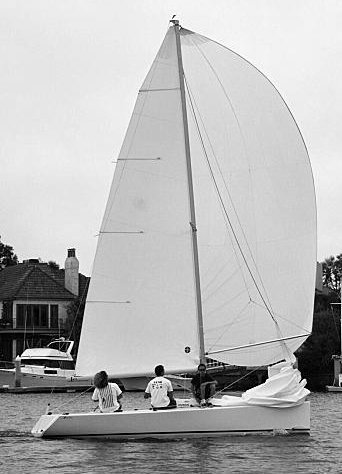

Governors cup 21 gc 21 for sale elsewhere on the web:

Main features
| Model | Governors cup 21 gc 21 | ||
| Length | 21 ft | ||
| Beam | 8.10 ft | ||
| Draft | 5 ft | ||
| Country | Italy (Europe) | ||
| Estimated price | $ 0 | ?? |
Login or register to personnalize this screen.
You will be able to pin external links of your choice.

See how Sailboatlab works in video
| Sail area / displ. | 26.31 | ||
| Ballast / displ. | 38.92 % | ||
| Displ. / length | 119.68 | ||
| Comfort ratio | 8.29 | ||
| Capsize | 2.73 |
| Hull type | Monohull fin keel with bulb and spade rudder | ||
| Construction | Fiberglass | ||
| Waterline length | 18.40 ft | ||
| Maximum draft | 5 ft | ||
| Displacement | 1670 lbs | ||
| Ballast | 650 lbs | ||
| Hull speed | 5.75 knots |

We help you build your own hydraulic steering system - Lecomble & Schmitt
| Rigging | Fractional Sloop | ||
| Sail area (100%) | 231 sq.ft | ||
| Air draft | 0 ft | ?? | |
| Sail area fore | 101.27 sq.ft | ||
| Sail area main | 130 sq.ft | ||
| I | 25.80 ft | ||
| J | 7.85 ft | ||
| P | 26 ft | ||
| E | 10 ft |
| Nb engines | 1 | ||
| Total power | 0 HP | ||
| Fuel capacity | 0 gals |
Accommodations
| Water capacity | 0 gals | ||
| Headroom | 0 ft | ||
| Nb of cabins | 0 | ||
| Nb of berths | 0 | ||
| Nb heads | 0 |
Builder data
| Builder | Bravura Yachts Inc. | ||
| Designer | Alan Andrews | ||
| First built | 2002 | ||
| Last built | 0 | ?? | |
| Number built | 11 |
Other photos
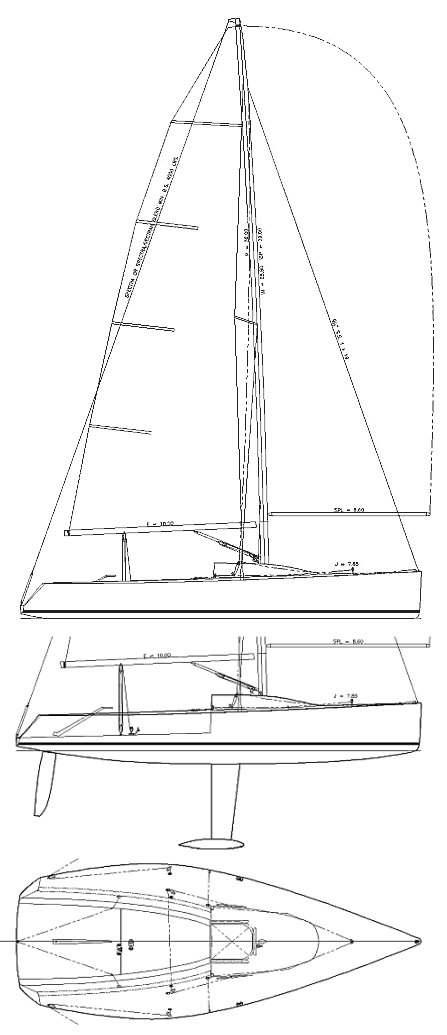
Modal Title
The content of your modal.
Personalize your sailboat data sheet

Fin w/bulb & spade rudder
Specifications GOVERNOR’S CUP 21 (GC-21)
Home - Sailboat Listings 2003 - 21.00 ft / 6.40 m - Alan Andrews - Bravura Yachts Inc. (USA)
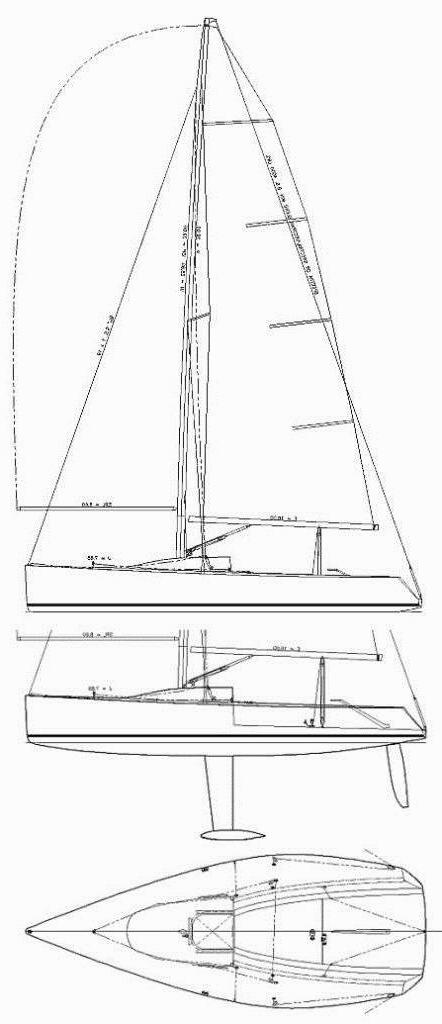
GOVERNOR’S CUP 21 (GC-21) Sailboat Data
Hull Type: Fin w/bulb & spade rudder Rigging Type: Fractional Sloop LOA: 21.00 ft / 6.40 m LWL: 18.40 ft / 5.61 m S.A. (reported): 231.00 ft² / 21.46 m² Beam: 8.10 ft / 2.47 m Displacement: 1,670.00 lb / 757 kg Ballast: 650.00 lb / 295 kg Max Draft: 5.00 ft / 1.52 m Construction: FG Ballast Type: Lead First Built: 2003 # Built: 11 Builder: Bravura Yachts Inc. (USA) Designer: Alan Andrews
Information from sailboatdata.com .
Hull Speed: 5.75 kn

ANDREWS GC21 (GOVERNOR´S CUP)

Eleven of these boats were built by Bravura Yachts (starting in late 2002). Some of the best sailors in the world come to Newport each year to compete the the ‘Gov Cup’. The one being offered at Tiller and Kites is #3 (built in March 2003). She is exactly as built and raced and includes the original Gov Cup sails. A Pettit ‘Black Widow’ antifoul bottom was added in 2017. If you are looking for a truly exceptional sailboat (with an AZ PHRF of 140) you certainly should consider this GC21. Arizona registered, launch trailer (with plates and title) and ready to sail and race .
- Condition: Excellent
- Length Overall (LOA): 21
- Make / Manufacturer: Andrews/Bravura
- Model Name / Number: Governor’s Cup 21
- Propulsion Type: Sail
- Year Manufactured: 2003
Tiller And Kites is a International Yacht Training accredited school based in Phoenix AZ. T&K boats are known for their distinctive shocking pink hulls. The IYT courses offered are designed specifically for sailing in the desert Southwest.
SOCIAL NETWORK

× You are using an outdated browser. Please upgrade your browser to improve your experience.
We Ship Worldwide! | FREE SHIPPING! for US Continental orders over $99. Click for details.

Shopping Cart
Your cart is currently empty..
FREE SHIPPING! for US Continental orders over $99 click for details
GovernorS Cup 21 Gc 21 - Sailboat Sheets

Pre-Spec sailboat sheets for your GovernorS Cup 21 Gc 21. Genoa, gennaker and spinnaker shets to fit your cruising or racing sailing style. Full range of options.
MAURIPRO Rigging shop brings years of expertise to the sailing community. Our riggers are constantly working with sailboat owners to provide high-quality genoa, mainsail and spinnaker sheets for their cruising or racing sailboats. From traditional polyester double braid to the latest on high tech lines made out of Dyneema or Stirotek, we offer a wide range of materials and diameters to fit any need of sailboat sheets.
We at MAURIPRO Sailing are looking forward to helping you the best way we can, but most importantly, we are looking forward to seeing you on the water. Let's Go Sailing!
Copyright © 2024 MAURIPRO Sailing LLC.
| | |
|
| |
|
for the NBSSA press release (118 kb PDF) on this exciting new design | ||

|
|
Review of Gulf Coast 21
Basic specs..
The hull is made of fibreglass. Generally, a hull made of fibreglass requires only a minimum of maintenance during the sailing season. And outside the sailing season, just bottom cleaning and perhaps anti-fouling painting once a year - a few hours of work, that's all.
The boat equipped with a masthead rig. The advantage of a masthead rig is its simplicity and the fact that a given sail area - compared with a fractional rig - can be carried lower and thus with less heeling moment.
The Gulf Coast 21 is equipped with a swing keel. A swing keel is a pivoting lifting keel, allowing to sail both coastal and inland waters.
The boat can sail close to the beach as the draft is just 0.25 - 0.35 meter (0.82 - 1.12 ft) dependent of the load. See immersion rate below.
Sailing characteristics
This section covers widely used rules of thumb to describe the sailing characteristics. Please note that even though the calculations are correct, the interpretation of the results might not be valid for extreme boats.
What is Capsize Screening Formula (CSF)?
The capsize screening value for Gulf Coast 21 is 2.50, indicating that this boat would not be accepted to participate in ocean races.
What is Theoretical Maximum Hull Speed?
The theoretical maximal speed of a displacement boat of this length is 5.6 knots. The term "Theoretical Maximum Hull Speed" is widely used even though a boat can sail faster. The term shall be interpreted as above the theoretical speed a great additional power is necessary for a small gain in speed.
The immersion rate is defined as the weight required to sink the boat a certain level. The immersion rate for Gulf Coast 21 is about 78 kg/cm, alternatively 438 lbs/inch. Meaning: if you load 78 kg cargo on the boat then it will sink 1 cm. Alternatively, if you load 438 lbs cargo on the boat it will sink 1 inch.
Sailing statistics
This section is statistical comparison with similar boats of the same category. The basis of the following statistical computations is our unique database with more than 26,000 different boat types and 350,000 data points.
What is Motion Comfort Ratio (MCR)?
What is L/B (Length Beam Ratio)?
What is a Ballast Ratio?
What is Displacement Length Ratio?
SA/D (Sail Area Displacement ratio) Indicates how fast the boat is in light wind: - Cruising Boats have ratios 10-15 - Cruiser-Racers have ratios 16-20 - Racers have ratios above 20 - High-Performance Racers have ratios above 24 Sail-area/displacement ratio (SA/D ratio): 19.06
Maintenance
If you need to renew parts of your running rig and is not quite sure of the dimensions, you may find the estimates computed below useful.
| Usage | Length | Diameter | ||
| Jib sheet | 6.2 m | (20.5 feet) | 10 mm | (3/8 inch) |
| Genoa sheet | 6.2 m | (20.5 feet) | 10 mm | (3/8 inch) |
| Mainsheet | 15.6 m | (51.3 feet) | 10 mm | (3/8 inch) |
| Spinnaker sheet | 13.8 m | (45.1 feet) | 10 mm | (3/8 inch) |
This section is reserved boat owner's modifications, improvements, etc. Here you might find (or contribute with) inspiration for your boat.
Do you have changes/improvements you would like to share? Upload a photo and describe what you have done.
We are always looking for new photos. If you can contribute with photos for Gulf Coast 21 it would be a great help.
If you have any comments to the review, improvement suggestions, or the like, feel free to contact us . Criticism helps us to improve.
RACE.FLY.LIVE EXPERIENCE THE GC32 CATAMARAN
| GC32 Racing T. | |
| Amount of events | 5 |
| Focus | Owner/Sponsor |
| Location | South Europa |
| Venue type | Small City |
| Hospitality Type | Informal |
| Racing Style | AC Course |
| Max Course Leg | 1.2 miles |
| Top Speed | up to 39 kts |
| Average Race time | 25min |
| Long distance race | sometime |
| # of races per day | 6 |
| Owner driver prize | yes |
| Pro's vs Owners | 50% / 50% |
- SPECIFICATIONS
- 12.00m Length (overall)
- 10.00m Length (hull)
- 6.00m Width
- 2.10m Max Board Draft
- 1.60m Max Rudder Draft
- 16.50m Mast Height (above beam)
- 6.60m Bow Sprit Length
- 975kg Total Boat Weight
- 55.30m2 3DI Raw Northsail Mainsail
- 19.02m2 3DI Raw Northsail Small Jib
- 24.17m2 3DI Raw Northsail Big Jib
- 88.00m2 3DI Raw Northsail Gennaker
GC32 Racing


- Marketplace
- GC32 Hall of Fame

Introducing the GC32
Conceived by Amsterdam-based French businessman Laurent Lenne (left) and designed by Dr Martin Fischer, the GC32 is a 10m long (12m including bowsprit) by 6m wide foiling catamaran, that is one of the world’s fastest racing yachts. It is aimed at both pro-sailing teams and private owners looking to experience the latest in ultra-high performance racing and a level of sailing boat technology – albeit simplified – typically only available to America’s Cup teams.

The first GC32 catamarans went sailing in Dubai, close to its builders Premier Composite Technologies, towards the end of 2012.
Three boats competed at the GC32s’ initial European season in 2013, the class making its race debut at Allianz Traunsee Woche in Austria.
For the first season the boats competed with their Mk1 foil package comprising a ‘double S’ configuration main foil/daggerboard and L-profile rudder. These were designed to reduce displacement, but not to cause the GC32 to fly.
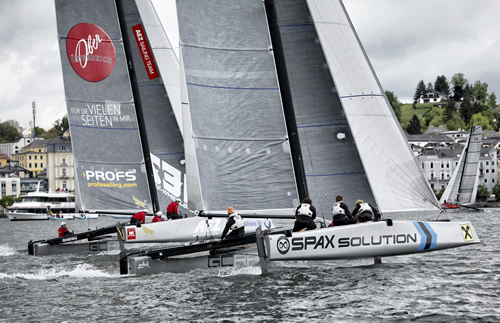
Inspired by the AC72s catamarans used in the 34th America’s Cup that fly above, rather than through, the water, the GC32 was fitted with its Mk2 foils in the spring of 2014. This transformed the GC32 into a fully flying foiling catamaran.
While the GC32 shares many similarities with the foiling America’s Cup catamarans, free from AC rule constraints it is a ‘better foiler’. The foil package and boat set up enables it to be sailed not just elite athletes but by sailors of varying experience, enabling amateur sailors and owners to experience the very latest technology in high performance yacht racing.

Being a one design enables the GC32 to be substantially cheaper than an America’s Cup catamaran. While in many ways it resembles a scaled-down version, the GC32 is very much easier to sail and to run because:
- It is fitted with a conventional catamaran rig with rotating mast and three sails (main, jib and genniker). Compared to an AC catamaran’s wing, the GC32’s rig configuration is easier for regular sailors to adapt to and makes the logistics of running the boat far simpler, in particular docking and transportation
- The GC32 has a more versatile foil package. The main lifting foils are large, allowing the boat to get airborne in the widest range of conditions (typically from 7 knots TWS up). The large foils also make for a relatively stable ride, reducing pitching.
- Contrary to expectation, the large foils seem to have little effect on top end speed, the boat capable of regularly hitting 30+ knots and a top speed approaching 40. The large foils also enable the GC32 to foil upwind in 20+ knots of TWS.
- Despite its impressive performance, the GC32 is easy to helm and get airborne, but, like most race boats, requires skill and practice on the part of a crew to become competitive.
- It is a one design, including a limitation on sails and the numbers of sails teams can use during a season. This prevents escalating costs.
- There are no hydraulics on board. The pitch of the rudder T-foil and J foil daggerboard can be altered, the latter during racing via a line-driven worm drive.
- As the boat is relatively light, it is easily road trailerable. The boat and rig can be fitted on to a custom-built open trailer or into a container on wheels.
Easier to sail
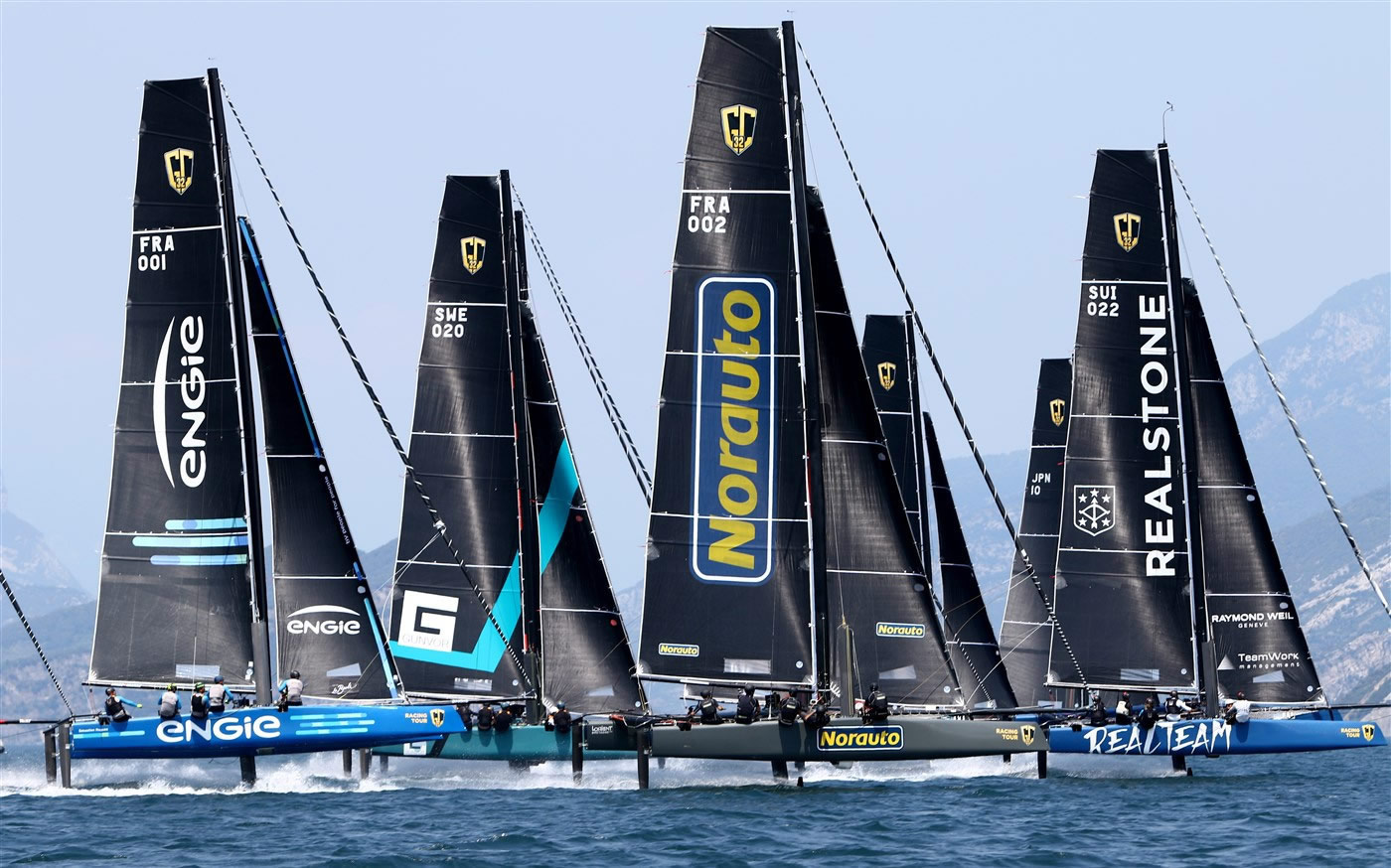
Today there are GC32s regularly sailing in Europe, North America and Australasia. Boats compete on the GC32 Racing Tour, which in 2019 comprised a series of five events in southern Europe and Oman, each event lasting four days with a practice race day beforehand. Until 2018 GC32s also competed in the Extreme Sailing Series but following its demise the two fleets consolidated on the GC32 Racing Tour for 2019. 2020 saw a cancelled season due to the world’s COVID-19 pandemic but is back for 2021 with a shortened four event season in Lagos, Portugal, Sardinia for the GC32 World Championship and Mar Menor for the first time.
The GC32s typically compete on America’s Cup-style courses with reaching or upwind starts (if conditions are light or heavy). Races are short, but the courses long enough for the foiling catamarans to reach their full speed potential. The GC32 Racing Tour is designed to provide the ‘best foiling experience’ with a choice of venues aimed at providing optimum conditions to go foiling and top racing for all competitors as a result.
The circuit, like the GC32 itself, is aimed at attracting professional and owner-driver teams. For the former there are both onboard and shore-based guest programs while the GC32’s media team communicates about and promotes the racing via television, photography, social media, press and direct mailing.
The racing is run by well known international PRO and successful yacht racer Stuart Childerley and has its own on the water umpire team and safety officer.
GC32s today

Length (overall): 12.00m Length (hull): 10.00m Beam: 6.00m Weight: 975 kg Draft (boards down): 2.10m Draft (rudder): 1.60m Mast height (above deck): 16.50m Bowsprit length: 6.60m Mainsail: 60.00m² Jib: 23.50m² Gennaker: 90.00m²
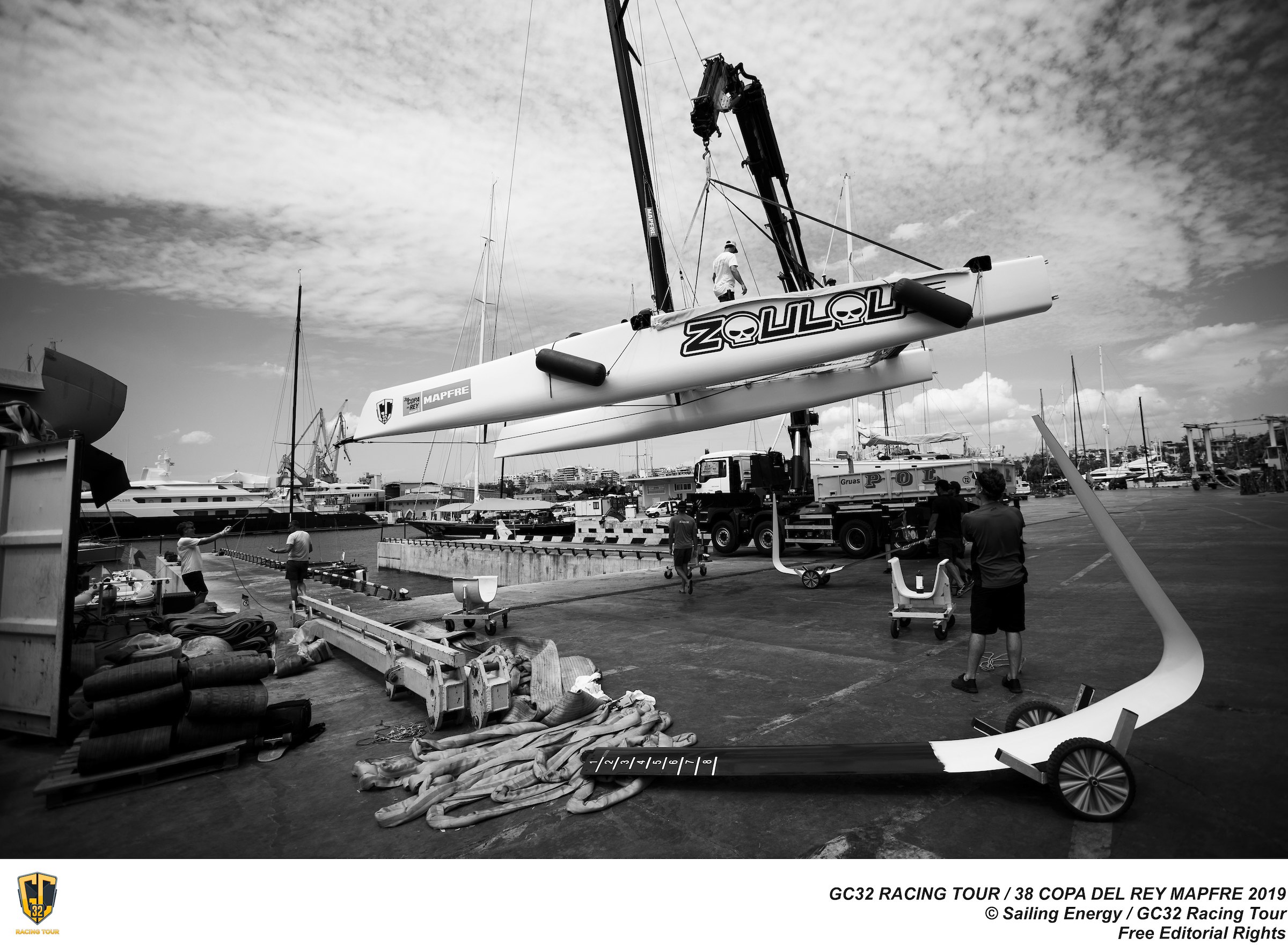
For more information contact
Christian Scherrer – GC32 IC Manager Phone: +41 794216217 Email: [email protected]
For used GC32 catamarans click here
For new boats and equipment:
Laurent Lenne – CEO The Great Cup BV www.thegreatcup.com Email: [email protected] Phone: +31 613347842
- New Sailboats
- Sailboats 21-30ft
- Sailboats 31-35ft
- Sailboats 36-40ft
- Sailboats Over 40ft
- Sailboats Under 21feet
- used_sailboats
- Apps and Computer Programs
- Communications
- Fishfinders
- Handheld Electronics
- Plotters MFDS Rradar
- Wind, Speed & Depth Instruments
- Anchoring Mooring
- Running Rigging
- Sails Canvas
- Standing Rigging
- Diesel Engines
- Off Grid Energy
- Cleaning Waxing
- DIY Projects
- Repair, Tools & Materials
- Spare Parts
- Tools & Gadgets
- Cabin Comfort
- Ventilation
- Footwear Apparel
- Foul Weather Gear
- Mailport & PS Advisor
- Inside Practical Sailor Blog
- Activate My Web Access
- Reset Password
- Customer Service

- Free Newsletter

Ericson 41 Used Boat Review

Mason 33 Used Boat Review

Beneteau 311, Catalina 310 and Hunter 326 Used Boat Comparison

Maine Cat 41 Used Boat Review

Tips From A First “Sail” on the ICW

Tillerpilot Tips and Safety Cautions

Best Crimpers and Strippers for Fixing Marine Electrical Connectors

Thinking Through a Solar Power Installation

Getting the Most Out of Older Sails

How (Not) to Tie Your Boat to a Dock

Stopping Mainsheet Twist

Working with High-Tech Ropes

Fuel Lift Pump: Easy DIY Diesel Fuel System Diagnostic and Repair

Ensuring Safe Shorepower

Sinking? Check Your Stuffing Box


The Rain Catcher’s Guide

Boat Repairs for the Technically Illiterate

Boat Maintenance for the Technically Illiterate: Part 1

Whats the Best Way to Restore Clear Plastic Windows?

Mastering Precision Drilling: How to Use Drill Guides

Giving Bugs the Big Goodbye

Galley Gadgets for the Cruising Sailor

Those Extras you Don’t Need But Love to Have

UV Clothing: Is It Worth the Hype?

Preparing Yourself for Solo Sailing

How to Select Crew for a Passage or Delivery

Preparing A Boat to Sail Solo

On Watch: This 60-Year-Old Hinckley Pilot 35 is Also a Working…

On Watch: America’s Cup

On Watch: All Eyes on Europe Sail Racing

Dear Readers

Chafe Protection for Dock Lines
- Sailboat Reviews
Venture 21 Used-boat Review
The vintage macgregor is a good example of a budget-friendly boat..
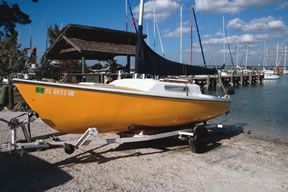
Maybe this has happened to you: You’re on a country road, driving to a wedding (or family vacation or business conference), and you pass a sailboat on a trailer with a “For Sale” sign. It’s not a big boat. It’s not a small boat. But it’s just about right for launching a small adventure with your young family, or maybe you’re looking to downsize. You can’t resist stopping for a closer look. Incredibly, the sign reads “$600,” including a nearly new trailer and an old 4-horsepower, two-stroke outboard that “runs like a top.” You write down the number and drive away, thinking: “Somebody is giving away a perfectly good boat.”
Chances are that “steal of a deal” is a Roger MacGregor-designed Venture 21, and if not, it’s probably one of the many copycats riding the trailer-sailer boom that MacGregor’s little boat ignited. The Catalina 22, the Santana 21, and the San Juan 21 are just some of the boats that followed closely in the wake of the Venture 21’s introduction.
The concept for the Venture 21 came out of MacGregor’s master’s thesis in the Stanford University MBA program. The first hull was introduced in 1965, but full-fledged production didn’t begin until 1967. Several thousand hulls later, the last MacGregor 21 (the boat was renamed in 1980) rolled off the line in 1986 at the MacGregor factory in Costa Mesa, Calif. Today, with some 36,000 sailboat hulls behind it, the company builds just one boat, the hybrid sailboat/powerboat MacGregor 26x.
Although MacGregor sold fewer Venture 21s than its successor—the Venture 22, which later became the pop-top Venture 22-2—the 21’s easy trailerability and affordable price helped it maintain its popularity throughout the 1970s. Capitalizing on the fiberglass revolution in boatbuilding, MacGregor’s business-school project sparked a pivotal marketing shift that helped bring recreational sailing to mainstream America.
While the trailer-sailer boom is far behind us, the Venture 21 and its many look-alikes have renewed relevance today. With their discretionary spending sharply cut, younger sailors are taking the Craigslist-route into sailing, scouring the classified ads for boats that don’t require dock space but still have room for a family sail. Meanwhile, many owners of 30-plus-footers are considering downsizing to a boat that doesn’t require mooring fees and a hefty maintenance bill each spring. For better or for worse, in the dim light of a recession, a back-to-basics giveaway boat on the roadside begins to look awfully enticing. For these and other reasons, PS decided to take a closer look at the Venture 21, which, in many ways, is the epitome of “the boat with a price I couldn’t refuse.”

The Venture 21 was designed to be affordable, easy to trailer and launch, and fun to sail, with enough room below for storing gear, napping, or even spending a night at anchor. It was principally aimed at new sailors, but it also appealed to those who wanted to step up from an open daysailer. Its size, sail area, and hull design were tailored for lakes and bays with fickle breezes of less than 15 knots.
Seaworthiness and performance were important considerations but pragmatism and aesthetic appeal were the driving force behind its design features.
Although the boat’s low headroom and Spartan interior would not qualify it as a weekender today, it was initially marketed as a “cruising” sailboat. A sleep-aboard sailboat that could be hauled around the country behind the family station wagon seemed perfectly in tune with the wanderlust of the 1960s.
While the Venture 21 is regarded as one of the first modern trailer-sailers, no single design element stands out as particularly revolutionary or unique. Instead, MacGregor incorporated proven features that would not only appeal to serious sailors, but also would remain consistent with the public perception of what a good boat should be and look like. In the yacht market, the Cruising Club of America boats were still the aesthetic model. Carl Alberg’s popular Ensign, launched by Pearson in 1962, is a good example of a small boat that clung to the CCA philosophy and aesthetic.
The Venture’s heritage is more closely aligned with two daysailers that were enjoying a surge of popularity on the East Coast in the early 1960s: the 17-foot Day Sailer, designed by George O’Day and Uffa Fox in 1958, and, to a lesser degree, the Phillip Rhodes-designed Rhodes 19, first offered by O’Day in 1959. Both were built by the nascent O’Day Group of Fall River, Mass. The similarities in the three boats are most apparent above the waterline. All have a relatively flat sheer line and spoon-like bow overhang (or spoonbow), elements that predate the modern yachting era.
While the Rhodes 19 still carries fairly deep V-sections well aft, making it a capable performer in the chop typical of its New England home waters, the Day Sailer flattens out, particularly at the stern, giving it fast, near-planing speeds off the wind. Fox and O’Day later refined this feature, earning Fox a reputation as the innovator of the planing dinghy. With a modest V-shape and a relatively fine bow, the Venture 21 lies somewhere between the two Rhodes 19 and the Day Sailer.
The Venture’s swing keel gives it 5 feet, 6 inches of draft—even more than its popular big brother, the Venture 25—and retracts to allow the boat to float in about 15 inches of water. (The brochure says 12 inches.)
Although the original design called for a fractional rig with a 22-foot mast, this was later changed to a masthead rig, giving it quite a bit of horsepower for its era. At the peak of its production in the late 1970s, the Venture 21 enjoyed popularity as a racing boat, with fleets springing up on the Gulf Coast, the Great Lakes, and the Northeast, as well as its home waters of Southern California. Although some owners have gone to the trouble of re-routing running rigging, fairing the keel, adding travelers and vangs, and replacing the pinned turnbuckles with threaded turnbuckles, we’d encourage someone inclined toward performance to look at a more modern hull with an active racing fleet.
One of the most notable features is the boat’s 7-foot cockpit, as big as that found in the much larger and heavier Catalina 22. However, unlike the Catalina 22, the San Juan 21, and the successively longer Ventures (V-22, V-23, V-25) that widened the cabintop to provide more interior space, the Venture 21 preserves enough sidedeck for crew to move forward . . . with care. Many V-21s, like the one we sailed, never had lifelines; others have had their lifelines removed. The standard single lifelines—low and poorly supported by widely spaced stanchions—offer a modicum of safety, but these are still less than ideal. In our view, lifelines are not a deal-breaker on a 21-foot daysailer, but if you have small children, a boat that is equipped with lifelines with a supporting pushpit and pulpit would be preferable.
The cockpit has a small lazarette, presumably to store fuel for the small bracket-mounted outboard, but this leads directly to the bilge, a bad idea that presents a potential fire risk. The original boats came equipped with top-grinding winches with short T-tracks for the jib. The boat we sailed had only a single fixed-point for the jib sheet. The end-of-boom mainsheet has a 4:1 purchase that spreads the load to each corner of the stern, a basic setup that limits trim options. Some owners modified the leads and added a mainsheet traveler, although this entails either raising the traveler over the tiller, or moving the sheet forward on the boom; both are compromise solutions.
A modest 18- by 18-inch fiberglass bow hatch allows ventilation down below, as well as a place for sails to be passed down. There is no anchor locker or chain pipe. The boat we sailed had an 8-inch diameter screw-on PVC deck plate that was apparently used as a chain pipe.
Overall, the deck has a functional layout, fine for its primary mission, which is to enjoy some time on the water with very little hassle.
Accommodations
The biggest drawback to the Venture 21’s emphasis on trailerability and a 1960s aesthetic is the lack of headroom below. By keeping the cabintop and topsides profile low, MacGregor produced a boat that, in our view, is better looking than the slab-sided models that followed. However, the end result is a very cramped interior. The VW-camper-inspired pop-top on the Venture 22-2, which came shortly after the Venture 21, offered a compromise that was adopted by a number of boats in this size range. Gradually, the intrinsic appeal of a low profile gave way to market demands. (MacGregor’s current and only model, the M26x, is a classic example of the wedding cake look that eschews traditional aesthetics for the sake of comfort below.)
With two quarter berths and a V-berth, the Venture 21 technically could sleep four, but this sort of arrangement probably would be brief and acrimonious. Although you could pack a lot of gear under the cockpit, actual locker storage is limited. Some ambitious owners have added sinks, small galleys, 12-volt systems, and port-a-potties below, but the boat’s cramped headroom restricts its suitability for more than a few days of cruising. For the 20-something adventurer with aspirations of camp-cruising on one of America’s many inland lakes, it will do just fine, but more than a couple of days aboard a boat this size will be a sure test of any marriage.
Construction
During the Venture 21’s 15-year production run, from 1965-1980, the materials and construction methods used for its deck, rig, structural components, and keel went through several changes. Construction of the hull itself, however, remained virtually unchanged. The hull was hand laid up with woven roven and mat. The layup schedule was a single unit of alternating mat and woven roven. Owners do report flexing in some spots, although we noted none on the boat we tested. The early boats are fairly resin rich, so hull thickness is not necessarily a reflection of strength.
The earliest Ventures had a stick-built interior, with bulkheads and bunks made of resin-coated cuts of plywood that were laminated in place. These earlier versions make it easier for owners to modify or rebuild an interior, and this is almost an inevitable project, given plywood’s propensity to rot and delaminate.
By the mid-1970s, MacGregor switched to a molded liner, which accelerated production and eliminated issues of rot, but added about 200 pounds to the total weight. Large sections of the boat are enclosed and filled with foam—a touted safety feature—but it is nonsense to consider the boat unsinkable, as some websites and blog posts suggest.
About 50 V-21s featured lead keels. The poured lead was anchored to a steel beam, and the entire construction sheathed in fiberglass. This process was not only expensive, but it also presented significant corrosion problems, as water eventually migrated into the fiberglass-encased keel.
Most models have solid iron keels; corrosion, however, is still a problem with these keels, but they can be removed, ground-down, faired, and sealed with an epoxy barrier coat to provide many more years of service. This is the biggest “problem” with the Venture 21, and any buyer should take a close look at the keel and the related components.
The original deck was plywood core, but this was later changed to balsa. In either case, rot is a potential problem (particularly in areas of the owner-installed deck hardware), but none of the 14 owners of Venture 21s who participated in our survey reported significant problems with deck rot.
The hull-to-deck joint was initially a bolted and adhesive-bonded shoebox joint, in which the lip of the deck flange fits over the hull just like a shoebox lid. This was later modified to an outward turning flange joint, with the hull lip turning outward to present a horizontal bonding surface for the deck. In both cases, the joint was bonded with a polyurethane adhesive sealant such as 3M 5200, bolted together, and then covered with an extruded aluminum and vinyl rubrail. Neither joint is as rugged as an inward-turning flange, but this is method is typical for a boat of this size.
Early versions of the Venture 21 were fractional rigs, but the majority were masthead rigs with overlapping jibs. An off-center backstay and upper and lower shrouds add support to the 22-foot mast. Early boats, like the 1969 model that we test sailed, did not have spreaders on the upper shrouds. In windy areas, where mast pumping is a noticeable problem, retrofitting spreaders—or looking for a more suitable boat—would be a good idea. The chainplates are through-bolted to the hull, eliminating the typically rot-prone attachment to plywood bulkheads found in some larger boats of this vintage. The original turnbuckles are the fixed-adjustment type that allow 1/8-inch adjustment intervals, making it hard to tune the rig at sea, but impossible to over-tighten, a common novice error.
The two biggest problems cited in our owners’ survey were the hand-crank keel winch and the keel-retaining bolt. Although the keel winches on later MacGregor models are braked mechanisms that will not spin freely under load, the one on the Venture 21 is a common ratchet-type trailer winch. If it is let go under load, the handle can whip around dangerously. Many owners have replaced this with a braked winch—a good idea, although these winches will require more maintenance. The keel-retaining bolt is a 3/8-inch diameter bolt that is slipped through a hole in the centerboard trunk and a corresponding hole in the keel. It is used to lock the keel in place when sailing in deep water, preventing the keel from flopping back into the hull should the boat capsize or surf down the face of a wave. The retaining bolts are commonly bent during a grounding, and any boat with a bent one should be inspected closely around the hull and keel trunk for other signs of damage.
Overall, the construction is light, but adequate for the boat’s designed purposes. If the deck isn’t too rotten, and the swing keel and keel box aren’t shot, most any other potential problem on the Venture 21 is easily remedied by someone who is handy and has the time.
Performance
During its heyday, the Venture 21 was promoted for it speed. MacGregor touted its position as the first of the “hot retracting keel boats” and the “fastest of its type,” with “planing speeds at over 16 miles per hour.” In this age of ultra-light monohulls and multihulls with eye-popping sail area (see PS, September 2009 and May 2010), this sort of hype seems quaint, but if you compare the Venture 21 to other boats of its era, it is clearly no slouch (See “Venture 21 in Context,” page 11). Its sail area/displacement ratio puts it ahead of several contenders, and its hull form—as mentioned—does give it an ability to hit double-digit speeds in the right hands.
The boat we test sailed was handicapped by ancient sails and an outboard that could not be fully tilted out of the water. Although the boat had a masthead rig, the headsail was a fractional working jib. A 140-percent genoa, found on many boats, would have added about 25 percent to the total sail area. To windward, the boat tacked smartly through 90 degrees, although we’d expect a boat with good sails to point higher. The boat was initially tender on the wind, but once the full effect of the 400-pound keel exerted its influence, the boat settled into a comfortable heel. Despite the deep bellies in her sails, the boat handled gusts surprisingly well, and by adjusting the swing keel’s depth, testers could easily achieve a balanced helm. Off the wind in 12 to 15 knots of breeze, we were able to sustain speeds of 7 knots under working sails alone with the keel almost fully retracted. While not wind-in-your hair sailing by today’s standards, it meets our definition of fun.
Conclusions
After spending some time aboard the Venture 21, we were reminded how much and how little has changed since the boat was introduced more than 40 years ago. Most comparable modern “weekenders” with big cockpits and modest cabins, like the Precision 21 or Catalina Capris 22, offer much more in terms of safety, systems (limited as they are), and modern conveniences. And entry-level daysailers like the thermo-molded Hunter 216 offer more in terms of performance options, such as a sprit for the asymmetrical sail and rigging conveniences like a hydraulic lifting keel. If true small-boat performance with a potential for one-design racing is what you’re after, then a boat like the J/22 presents a more sensible choice.
While overall construction quality has improved over the past 40 years, most daysailer hulls (the Hunter 216 and the balsa-cored J/22 excepted) are still solid fiberglass and laid up by hand, an economical and forgiving method. Many daysailers with cabins are actually much heavier than the lightly built V-21, but they also have much better finish quality.
The bottom line with the Venture 21 is the bottom line. If you hunt around long enough, you are likely to pick up a sailaway boat with a trailer and outboard for less than $3,000—about the cost of a new trailer. The boat we sailed sold for far less, including the trailer and 4-horsepower Evinrude. If you are really patient, you can probably find a fixer-upper that someone will give to if you promise to drag it off their property.
Is this 40-year-old, mass-produced boat still a viable option for the entry-level sailor, or someone looking to downsize? No question about it. The Venture 21 is not a boat we’d recommend for someone with offshore aspirations or in places like San Francisco Bay where heavy air and a stiff chop would render it wet, slow, and uncomfortable. However, if you plan some coastal or lake adventures and are limited by a 2,000-pound tow capacity and a recession-era budget, then the Venture 21 definitely deserves a look.
There is one key caveat: Because it is easy to underestimate the amount of work required to revive barn-found boat, we would strongly urge looking for a Venture 21 that is in sailaway condition, rather than a project boat. Dealing with the iron keel alone can be a time-consuming project, and despite the boat’s interesting history, this adds little or no to resale value. On the good side, however, should you decide to embark on the restoration of a Venture 21, you will not be alone. Plenty have done it before, and given the boat’s irresistibly low price tag, more will surely follow in their wake.
RELATED ARTICLES MORE FROM AUTHOR
What kind of Trailer did your boat have. Mine (1972) is a 4″ welded C Channel, Is this a factory style trailer or somebody’s back yard built. It has the right v notches for the C/B etc.
LEAVE A REPLY Cancel reply
Log in to leave a comment
Latest Videos

What’s the Best Sailboats for Beginners?

Why Does A Sailboat Keel Fall Off?

The Perfect Family Sailboat! Hunter 27-2 – Boat Review

Pettit EZ-Poxy – How to Paint a Boat
Latest sailboat review.
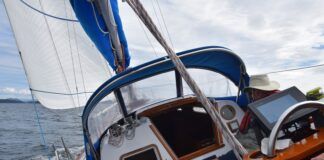
- Privacy Policy
- Do Not Sell My Personal Information
- Online Account Activation
- Privacy Manager

- Forum Listing
- Marketplace
- Advanced Search
- About The Boat
- Boat Review Forum
- SailNet is a forum community dedicated to Sailing enthusiasts. Come join the discussion about sailing, modifications, classifieds, troubleshooting, repairs, reviews, maintenance, and more!
Cal 21: Sailing traits & build quality
- Add to quote
In the ongoing quest for cheap old picnic cruisers under $3000.... There are many 1970s Cal 21s for sale, often for a little as $1500. At 1100 lbs, it's lighter than the SJ21, but it still has a retracting keel w/ 350# of ballast. Floats in 9" of water, which is important. How well-built were the small Cals? Were they reasonably good to sail? What problems did they have I should watch out for?
sharkbait said: I've got an old cal 29 and there have been a "few" occasions when,due to navigational inconsistencies,I've bumped a rock or two.The only thing damaged was my pride and some bottom paint. Click to expand...
I had a Cal 21 a few years ago. Prior to that, a Grumman 16, Holder 20, Prindle 15, and a Grampian 26. Subsequently I've had an O'Day 20, and a Catalina 309. The Cal 21 was the worst boat I've ever had. By far. It was built well enough, but unlike my other boats, it used plywood bulkheads tabbed to the hull rather than a fiberglass liner. Not necessarily a bad construction technique, but you'd definitely want to look for punk in the bulkheads near the hull in case the boat ever had standing water in it. But, my objection to the Cal was not its construction. It just sailed crappy. My other boats have all had their quirks to be dealt with, but the Cal seemed to do just about everything poorly. I found the boat very tender to sail, with a lot of weather helm. The keel on the 21 is, IMHO, a real piece of crap. Lowering and raising the keel is a pain in the neck. In contrast, the O'Day 20 I had after the Cal sailed like a dream. Sailed stiffer, less weather helm, and you could tie off the tiller and go forward without all hell breaking loose (actually continued to go in the same direction, UNLIKE the Cal). My particular Cal was in good condition with good gelcoat, etc., and to my eye was a good looking boat. It is, however, the only boat I've owned that I deeply regretted owning. My guess would be that the Cal 21 could be picked up at a considerable savings, considering its shortcomings. There are a lot of great Cals out there, but the 21 marked a low point (at least I hope they don't have any others as bad as the 21).
Additional candidate Siamese: Thanks for the opinion; I wondered about its tracking ability, given a fairly radical slipper shape. Looks like a drift boat! Even the revered SJ21 has dark hints attached about steering, and it's nowhere near as rockered as the Cal. I know the bigger Cals have good reps. The little one looks chintzy, tho. Let's throw the Balboa 21 into the hopper -- chunky hull, but I've read glowing reports on its quality and manners. Opinions? How's the keel to deal with?
I own a 21'Cal but do not recognize the boat described above. I'd certainly concur that one should over a boat that had had standing water in her hull; any boat. The hull is solid fiberglas, the decks plywood cored. The keel is not designed for sailing partially retracted, not to say one couldn't, but I'm not sure to what effect. If the pivot is in good shape you shouldn't have much trouble with it. It does weigh 400 lbs. I do not regard the boat as excessively tender although you can certainly alter her handling with some well placed crew. The only significant drawback to the boat is that there is not much headroom. The 21' is similar is size to the 20', albeit without the fixed keel. She carries more canvas than the 20' and perhaps the previous poster was alluding to the fact that you can over power her. I normally find about five degrees weather helm. The really big upside to her is that, at 1100 lbs, and 400 of that in the keel bulb, the lightest air will get her going. Like many Lapworth's she'll surf down wind. My 1973 had the original deck hardware, and still would but for my monkeying around. I've had mine six years now and virtually all of the maintenance I've done has been preventative. The boats hold up well. I've had zero deck core issues and have neither heard of blistering nor experienced any. Stepping the mast is easier with two but can be done alone with practise. We generally, when trailering, have the mast stepped, boat launched, and keel lowered in just under forty five minutes. The boat will tow easily with just a minivan. The boat tacks well and accellerates quickly. I regularly single hand and have found little reason not to sail on and off my mooring. If she just had a touch more headroom, but then she wouldn't be a Cal. Feel free to PM me if you wish.
sailaway21 said: I own a 21'Cal but do not recognize the boat described above. I'd certainly concur that one should over a boat that had had standing water in her hull; any boat. The hull is solid fiberglas, the decks plywood cored. The keel is not designed for sailing partially retracted, not to say one couldn't, but I'm not sure to what effect. If the pivot is in good shape you shouldn't have much trouble with it. It does weigh 400 lbs. I do not regard the boat as excessively tender although you can certainly alter her handling with some well placed crew. The only significant drawback to the boat is that there is not much headroom. The 21' is similar is size to the 20', albeit without the fixed keel. She carries more canvas than the 20' and perhaps the previous poster was alluding to the fact that you can over power her. I normally find about five degrees weather helm. The really big upside to her is that, at 1100 lbs, and 400 of that in the keel bulb, the lightest air will get her going. Like many Lapworth's she'll surf down wind. My 1973 had the original deck hardware, and still would but for my monkeying around. I've had mine six years now and virtually all of the maintenance I've done has been preventative. The boats hold up well. I've had zero deck core issues and have neither heard of blistering nor experienced any. Stepping the mast is easier with two but can be done alone with practise. We generally, when trailering, have the mast stepped, boat launched, and keel lowered in just under forty five minutes. The boat will tow easily with just a minivan. The boat tacks well and accelerates quickly. I regularly single hand and have found little reason not to sail on and off my mooring. If she just had a touch more headroom, but then she wouldn't be a Cal. Feel free to PM me if you wish. Click to expand...
Thanks, Sailaway -- I was hoping you would chime in, given your long experience with this boat. Headroom's never going to be easy on picnickers this size, but for me the cabin is mainly stowage, a place to duck in bad weather, and a sleeping option where camping isn't feasible. Can't stand up in my tent, either! Another boat that has me really intrigued -- the Tanzer 22. That's a luscious-looking ride, and people seem to think it's more seaworthy than most small cruisers. Two foot draft is pushing things. Also the S2 6.9, with a 10" draft. Wierd cabins on the S2s. May be too racy for singlehanding? ETA: Scratch the Tanzer22 -- it's a sweet boat to these eyes, but the CB/keel version is 3100 lbs! It has, basically, a San Juan 21 as ballast. Minivan would blow up.
bobmcgov said: Thanks, Sailaway -- I was hoping you would chime in, given your long experience with this boat. Headroom's never going to be easy on picnickers this size, but for me the cabin is mainly stowage, a place to duck in bad weather, and a sleeping option where camping isn't feasible. Can't stand up in my tent, either! Click to expand...
Have you Cal21 owners experienced any leaking around the keel pivot pin? That seems like a common issue with this boat. & I wonder if Siamese's difficulties could be attributed to sail condition or mast rake -- suspect anything less than a crisp, trim sail or perfectly located center of effort would make this boat yaw radically. Did you use adjustable backstays to fool with mast rake?
I have not had any trouble with the pivot pin. I suppose if you had the locking pin inserted and had a good hard grounding you could really stress that area. And, don't quote me on it, but I'd bet the pivot pin is above the waterline as well. I have not had the keel out of her. Leaking, in my opinion, is more likely to occur in the cockpit deck joint to keel trunk joint, and this joint is easily accessible for repair. I do not have an adjustable backstay and have felt no need for one. I would expect a baggy main or too much sail to explain excessive weather helm. I'd emphasize that this boat carries a decent amount of sail for her 1100lb displacement and she doesn't need much of either wind or sail to raise her heels. I find her quite easy to sail, single handed, and very forgiving in her handling. And I'm due for new sails so I expect to enjoy her even more when I'm poorer. "Nodrog" is for sale up in Mass I believe and she's been owned by the same family since new. I thought they'd never sell her. Her owners comments are on the Cal 21 web-site. http://www.calyachts.org/ The overall consensus on the boat seems to be that she's a blast to sail, the keel can be a bit of a pain to raise and lower until familiarity sets in, and that it's a boat that does most things quite well, none poorly, meeting a lot of diverse needs in a trailerable sailboat. Mine has a hatch added for a lazerette in the aft cockpit and it's a welcome addition. I'm going to redo the hatch cover to make it more seaworthy fashioned. The cockpit drains well although I redid and enlarged the seat drains just because. The designed nature of the boat is such that modifying the boat to suit your purposes is quite easy, the keel trunk being the only significant obstacle to work around. I suspect that most of the boats are sailing about without their keel pinned and this does provide some give in grounding with no apparent effect at large angles of heel. I've made up a pin for mine as she had none on purchase, and from the looks of things, none was used much ever. Deck delamination is most likely to be found in the cockpit seats if anywhere, as water can sit there if the drains become plugged/deterioated. You'll want to make sure that you either have or make up a keel board keeper. The plans for it are on the web-site somewhere. It helps keep the keel down, how much I do not know as I've never sailed without it, and it's essential for keeping the cockpit footings dry. It's easy to make one in about an hour and easy to install after lowering the keel. A plywood footing fits over it and the keel well for a nice finished look once the keel is lowered. I've fitted an autopilot to my tiller, although the Davis tiller-tamer and sail adjustment work adequately for day-sailing. To be honest, the first negative comments I've heard about the boat have been here. I'm surprised. They're not selling for a ton of money by any measure and are a very easy boat to own in terms of maintenance, launching, towing, and storage. One must be careful that rudder and outboard do not meet during operation, but that's a common danger in this size boat.
I'm suprised with the negative comments, too. I owned a 1971 Cal 21 "Joy" for several years and was competely satisfied with her. Abeit, as pointed out below decks was somewhat cramped for more then 2 adults and 2 small kids for more than sitting, but we fair weather camped out and slept in the cockpit and on deck. As compared to the Cal 20, the Cal 21 is quite a bit tender but they are for two different applications... the Cal 20 with its fixed 900 lb keel would be a ***** to trailer and I wouldn't sail the Cal 21 in the SF bay. If one is planning to purchase, scrutinze the keel and its bunk. The classic problem is that the user could loose control of the extending or retracting process and the keel will swing with a good bit of momentum and crack the trunk and/or bend the keel bolt. Which accounts for some of the leaking keel bolt problems, ours weeped somewhat. Joy was modified with a cable that was fixed to the end of the keel so that it would never slip off. There is good support for the boat concerning fixes and mods. Check out ttp://www3.sympatico.ca/sailpair/21stuff/home.html . I always considered Gordon (NODROG's namesake) and Rod Johnson as the gurus of the Cal 21.
Cal21-"Nodrog" is for sale The boat that Scott and I have mentioned is still for sale. I received an e-mail on the sailnet Cal e-mail service. I also looked up the old photos from the old Cal site. If anyone is still looking for a nice trailer-sailer this might be just the one. A brief perusal of the Cal site and you'll see that this family was pretty fanatical about their 21' Cal, I'd be much surprised if she is not in good condition. Let's see if I can make the links work here. (g) found the following link to work well Loading... -----Original Message----- From: cal [mailto:cal] Sent: Monday, April 21, 2008 2:50 PM To: cal Subject: [cal] 1970 CAL 21 for sale Well, after having owned NODROG for 38 years, my Dad has reluctantly been trying to sell her for the past year. If you know of anyone looking to give a nice CAL 21 a good home, here is the link to our classified ad. http://www.bestboatbuys.com/featured_detail_id.las?id=5BXwdNNgWHH5xfuMd I can provide more details on the equipment list, or just send my Dad an e-mail using the e-mail link in the ad. We do not have a trailer since we kept her on a mooring each summer. Price is a very reasonable $2500.00, but we might consider offers. Rod Johnson, "NODROG" 1970 CAL 21, #285 This one has some good photos of the boat within: http://www.cal21.com/ I have not seen this boat, it does not come with a trailer, and while I have no interest financially in the boat, the owners of her have been very prominent in the Cal21 circle. Definitely worth a look at $2500 negotiable.
Love the trailerability of the Cal 21. Bought the boat in Milwaukee and trailered it to Minneapolis with no problems using my Saturn (4 cyl) to pull it.
- ?
- 176.1K members
Top Contributors this Month
- Manage Account
- Best in DFW
- Life & Loss In Dallas
- Things to Do
- Public Notices
- Help Center
Man drowned after trying to save teen at Lake Waxahachie, police say
Personnel responded saturday afternoon to boat dock park and learned of the drowning..

Breaking news reporter
2:55 PM on Aug 27, 2024 CDT — Updated at 4:27 PM on Aug 27, 2024 CDT

A 21-year-old man drowned after trying to save a teenage girl Saturday at Lake Waxahachie, police say.
Police and fire department personnel responded about 12:45 p.m. to Boat Dock Park at the lake and learned the man — identified by police as Lincer Lopez Mejia — had drowned as he tried to rescue the teenager, who was in distress while in the water.
Related: Here’s how to stay safe while enjoying North Texas’ lakes and waterways
The girl, who was part of a large church group from Garland, was pulled from the water by a boater from Red Oak and given CPR. She was “successfully revived” and taken to a hospital, police said in a news release.
Get the latest breaking news from North Texas and beyond.
By signing up you agree to our Terms of Service and Privacy Policy
The man was also recovered from the lake and taken to a hospital, where he was pronounced dead. The police department said it extended its “deepest condolences to the victim’s family.”

Aria Jones , Breaking news reporter . Aria writes about breaking news. She is a graduate of the University of Texas at Austin and Dallas College. Aria has interned at the Austin American-Statesman, the Texas Tribune and the El Paso Times.
Great choice! Your favorites are temporarily saved for this session. Sign in to save them permanently, access them on any device, and receive relevant alerts.
- Sailboat Guide
GC32 is a 32 ′ 9 ″ / 10 m catamaran sailboat designed by Dr Martin Fischer and built by Premier Composite Technologies starting in 2012.
Rig and Sails
Auxilary power, accomodations, calculations.
The theoretical maximum speed that a displacement hull can move efficiently through the water is determined by it's waterline length and displacement. It may be unable to reach this speed if the boat is underpowered or heavily loaded, though it may exceed this speed given enough power. Read more.
Classic hull speed formula:
Hull Speed = 1.34 x √LWL
Max Speed/Length ratio = 8.26 ÷ Displacement/Length ratio .311 Hull Speed = Max Speed/Length ratio x √LWL
Sail Area / Displacement Ratio
A measure of the power of the sails relative to the weight of the boat. The higher the number, the higher the performance, but the harder the boat will be to handle. This ratio is a "non-dimensional" value that facilitates comparisons between boats of different types and sizes. Read more.
SA/D = SA ÷ (D ÷ 64) 2/3
- SA : Sail area in square feet, derived by adding the mainsail area to 100% of the foretriangle area (the lateral area above the deck between the mast and the forestay).
- D : Displacement in pounds.
Ballast / Displacement Ratio
A measure of the stability of a boat's hull that suggests how well a monohull will stand up to its sails. The ballast displacement ratio indicates how much of the weight of a boat is placed for maximum stability against capsizing and is an indicator of stiffness and resistance to capsize.
Ballast / Displacement * 100
Displacement / Length Ratio
A measure of the weight of the boat relative to it's length at the waterline. The higher a boat’s D/L ratio, the more easily it will carry a load and the more comfortable its motion will be. The lower a boat's ratio is, the less power it takes to drive the boat to its nominal hull speed or beyond. Read more.
D/L = (D ÷ 2240) ÷ (0.01 x LWL)³
- D: Displacement of the boat in pounds.
- LWL: Waterline length in feet
Comfort Ratio
This ratio assess how quickly and abruptly a boat’s hull reacts to waves in a significant seaway, these being the elements of a boat’s motion most likely to cause seasickness. Read more.
Comfort ratio = D ÷ (.65 x (.7 LWL + .3 LOA) x Beam 1.33 )
- D: Displacement of the boat in pounds
- LOA: Length overall in feet
- Beam: Width of boat at the widest point in feet
Capsize Screening Formula
This formula attempts to indicate whether a given boat might be too wide and light to readily right itself after being overturned in extreme conditions. Read more.
CSV = Beam ÷ ³√(D / 64)
Length (overall): 12.00m/38.37’ Length (hull): 10.00m/32.81’ Beam: 6.00m/19.68’
Foiling Catamaran (Mk2 re-designed foils in the spring of 2014) Draft (boards down): 2.10m/6.89’ Draft (rudder): 1.60m/5.25’ Bowsprit length: 6.60m/21.65 Mainsail: 60.00m² Jib: 23.50m² Gennaker: 90.00m²
CONTACT: Laurent Lenne – CEO The Great Cup BV Email: [email protected] Phone: +31 613347842
THE GREAT CUP BV De Corentijn 77 1689 AN Zwaag Holland
Embed this page on your own website by copying and pasting this code.
- About Sailboat Guide
©2024 Sea Time Tech, LLC
This site is protected by reCAPTCHA and the Google Privacy Policy and Terms of Service apply.

IMAGES
COMMENTS
The GOVERNOR'S CUP 21 (or GC-21) was commissioned by and the first 11 were built for the Newport Balboa Sailing and Seamanship Association (NBSSA) as a match racer for the Governor's Cup Match Racing Series, first held in California in 1967. ... Like the LWL, it will vary with the weights of fuel, water, stores and equipment. A boat's actual ...
The GOVERNOR'S CUP 21 (or GC-21) was commissioned by and the first 11 were built for the Newport Balboa Sailing and Seamanship Association (NBSSA)as a match racer for the Governor's Cup Match Racing Series, first held in California in 1967. Governor's Cup 21 (GC-21) is a 20′ 11″ / 6.4 m monohull sailboat designed by Alan Andrews and ...
The Governors cup 21 gc 21 is a 21.0ft fractional sloop designed by Alan Andrews and built in fiberglass by Bravura Yachts Inc. since 2002. 11 units have been built. The Governors cup 21 gc 21 is a light sailboat which is a very high performer. It is stable / stiff and has a low righting capability if capsized. It is best suited as a day-boat.
The Governor'S Cup 21 aka GC 21 is a small sailboat designed by the American maritime architect Alan Andrews in the early 2000. Only a few boats have been produced. The Governor'S Cup 21 is built by the American yard Bravura Yachts Inc. . Here we would have liked to show you nice photos of the Governor'S Cup 21.
GOVERNOR'S CUP 21 (GC-21) Sailboat Data Hull Type: Fin w/bulb & spade rudder Rigging Type: Fractional Sloop LOA: 21.00 ft / 6.40 m LWL: 18.40 ft / 5.61 m S.A. (reported): 231.00 ft² / 21.46 m² Beam: 8.10 ft / 2.47 m Displacement: 1,670.00 lb / 757 kg Ballast: 650.00…
New member. 41. 0. MEXICO. Jun 17, 2004. #14. The gov gup 21 is a nice looking little yacht but is not much faster than the santana 21, my thoughts are that it should be much faster. The hull is ok but has to much formed stablity so roll tacks are slow.
ANDREWS GC21 (GOVERNOR´S CUP) Eleven of these boats were built by Bravura Yachts (starting in late 2002). Some of the best sailors in the world come to Newport each year to compete the the 'Gov Cup'. The one being offered at Tiller and Kites is #3 (built in March 2003). She is exactly as built and raced and includes the original Gov Cup sails.
Sailboat data, rig dimensions and recommended sail areas for Governor's Cup 21 (Gc-21) sailboat. Tech info about rigging, halyards, sheets, mainsail covers and more.
Pre-Spec sailboat sheets for your GovernorS Cup 21 Gc 21. Genoa, gennaker and spinnaker shets to fit your cruising or racing sailing style. Full range of options.
First 12 boat fleet has received top reviews from Governors Cup, Balboa Challenge Cup, Sears Cup, ICSA Sloop Nationals. Additional GC 21's are racing in Toronto and Newport Beach, CA. For price and delivery contact The Yacht Barn, Inc. at (714) 273-3800.
2 sailboats built by Bravura Yachts Inc. Sailboat. Governor's Cup 21 (GC-21) 2002 ...
The immersion rate is defined as the weight required to sink the boat a certain level. The immersion rate for Gulf Coast 21 is about 78 kg/cm, alternatively 438 lbs/inch. Meaning: if you load 78 kg cargo on the boat then it will sink 1 cm. Alternatively, if you load 438 lbs cargo on the boat it will sink 1 inch.
Guaicamacuto. -class patrol boat. 11.8 m (38 ft 9 in) (max.) [2] The Guaicamacuto-class patrol boats (Avante 1400) is a class of offshore patrol vessels or BVL ( Spanish: Buque de Vigilancia de Litoral) in Venezuelan Navy service for patrol duty in economic exclusive zone. A contract for four BVLs and four POVZEE was signed together on 25 ...
THE GREAT CUP is commited to create a great boat, but also to create several great opportunities to sail the GC32. Nowadays, you can sail the GC32 on the GC32 Racing Tour and at 1 single world class event. ... The GC#2 Word Championship is the epic moment of the class. Come to join us! A FAST, SAFE AND ROBUST BOAT The usual comments heard about ...
The boat and rig can be fitted on to a custom-built open trailer or into a container on wheels. Easier to sail. Today there are GC32s regularly sailing in Europe, North America and Australasia. Boats compete on the GC32 Racing Tour, which in 2019 comprised a series of five events in southern Europe and Oman, each event lasting four days with a ...
2004 Chaparral 210 SSi | 21' Fallston, MD 21047. $13,000. Engine. Volvo. Total Power. 195hp. Engine Hours. 520. Class. Runabout. Length. 21ft. Year. 2004. Model. 210 SSi. Capacity- ... Premium resin, foam injection and quad radial lamination create a boat that's built to last in the classic Chaparral tradition. Stainless steel hardware adds ...
Gulf Coast 21 is a 20′ 6″ / 6.3 m monohull sailboat designed by Martin Bludworth and built by Gulf Coast Sailboats starting in 1972. Great choice! Your favorites are temporarily saved for this session. ... The lower a boat's ratio is, the less power it takes to drive the boat to its nominal hull speed or beyond. Read more. Formula. D/L = (D ...
Today, with some 36,000 sailboat hulls behind it, the company builds just one boat, the hybrid sailboat/powerboat MacGregor 26x. Although MacGregor sold fewer Venture 21s than its successor—the Venture 22, which later became the pop-top Venture 22-2—the 21's easy trailerability and affordable price helped it maintain its popularity ...
21.6mm Neck Thickness (near 12th fret)-Neck Thickness (near 12th fret) Scale 648mm (25.5") RADIUS-RADIUS Strings for setup MATSUOKA MC1000HT / High Tension Repair and Maintenance Cleaning, string replacement, rod adjustment, octave adjustment, string height adjustment, ironing correction, and matching
I had a Cal 21 a few years ago. Prior to that, a Grumman 16, Holder 20, Prindle 15, and a Grampian 26. Subsequently I've had an O'Day 20, and a Catalina 309. The Cal 21 was the worst boat I've ever had. By far. It was built well enough, but unlike my other boats, it used plywood bulkheads tabbed to the hull rather than a fiberglass liner.
GULF COAST 21. Save to Favorites . Beta Marine. BOTH. US IMPERIAL. METRIC. Sailboat Specifications Definitions ... 1997), states that a boat with a BN of less than 1.3 will be slow in light winds. A boat with a BN of 1.6 or greater is a boat that will be reefed often in offshore cruising. Derek Harvey, "Multihulls for Cruising and Racing ...
A 21-year-old man drowned after trying to save a teenage girl Saturday at Lake Waxahachie, police say. Police and fire department personnel responded about 12:45 p.m. to Boat Dock Park at the lake ...
The New CAL 21 Sailboat: Perfect for Racing or Cruising (1970) Loaf along at 50 knots. Or cruise at 5. Loaf along at 50 knots to your most successful racing/cruising favorite cruising grounds. You can explore new lakes, bays, and harbors every weekend -- in the new CAL 21. For launching, any beach ramp and 12 inches of water are all you need.
GC32 is a 32′ 9″ / 10 m catamaran sailboat designed by Dr Martin Fischer and built by Premier Composite Technologies starting in 2012. Great choice! Your favorites are temporarily saved for this session. Sign in to save them permanently, access them on any device, and receive relevant alerts. ... Bowsprit length: 6.60m/21.65